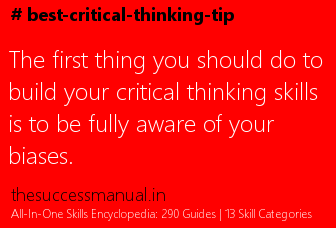Critical Thinking Skills: A Simple Guide
Critical thinking
1. What is critical thinking?
Critical thinking is thinking for yourself and understanding the difference between fact and opinion. It is the opposite of parroting off what you have heard others say/write.
The saying goes, 'Fact is what people I agree with tell me. Fiction is what people I disagree with tell me.'
Most of the time we believe what we want to believe. That's not all.
We also fall for 'persuasion tricks' of others. They will play to our emotions, hiding/downplaying the important facts and we fall under their spell easily.
Critical thinking is you fully understanding the useful information (ask 'why' five times, if you want to), and then use what you have learnt to form your own opinion or decision or plan.
Using critical thinking, we can:
- Identify the main issues and assumptions in an argument
- Recognize the important relationships between ideas and people
- Make correct inferences/conclusions from data before us
- And also evaluate evidence or authority (this is very important - verify the 'experts')
2. Critical thinking 101
- The first thing you should do to build your critical thinking skills is to be fully aware of your biases:
We like to be told what we already know. This is a big truth applicable to everyone, however smart they may be. To be a good critical thinker, to able to judge other people's B.S., we need to get out of our echo chamber, confront our biases ('search Google for 'cognitive biases') and get ready for competing points of views on any issue close to our heart.
- The second most important thinking is critical thinking is to ask 'why' ('The Toyota Method'), as many times you need to.
And then ask all other questions you want.
- The next most important thing is to look closely, noticing the finer details about what you have just heard/read:
Who benefits from this information? How trustworthy and genuine is the source? What are they really trying to saying all that fancy words and facts? What is it that they are hiding? That they are not saying but is the truth? What details have they used (and left out) in their arguments?
- List opinion(s) from all relevant sides of an issue and collect logical argument(s) supporting each.
Break the arguments into their constituent statements and draw out various additional implication(s) from these statements.
Examine these statements and implications for internal contradictions.
Locate opposing claims between the various arguments and assign relative weightage (better weightage to claims with strong support, less weightage to claims with not much support) to opposing claims:
- You should also practice your critical thinking watching talking heads argue on TV news or watching big time politicians argue:
What are they leaving out?
Whenever you are watching people argue, ask: 'What is the counter argument?' (Source: Scott Berkun)
- Whenever a person uses 'qualifying phrases', it is sign they are hiding something:
'I want to say, I'm just saying, To be perfectly honest, I just want you to know, To tell you the truth, I'm not saying, I hear what you're saying, Don't take this the wrong way, Let's be frank, As far as I know, I'm thinking that, Surely...'
(Source: Wall Street Journal)
❤ If you liked this, consider supporting us by checking out Tiny Skills - 250+ Top Work & Personal Skills Made Easy